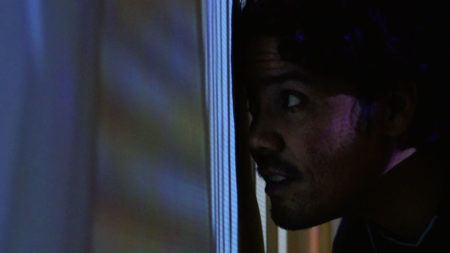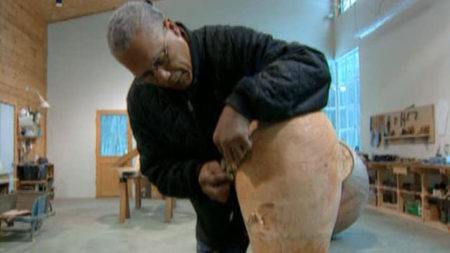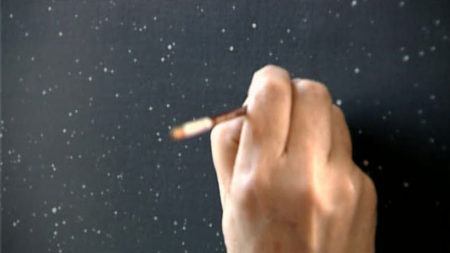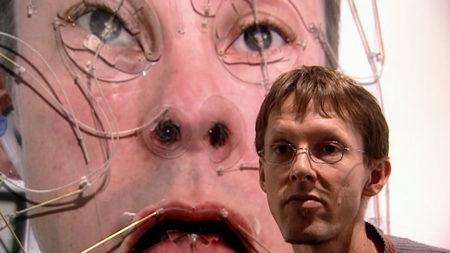Continue playing
(Time remaining: )
Play from beginning
Continue playing "{{ controller.videos[controller.getVideo(controller.currentVideo)].segmentParentTitle}}"
{{controller.videos[controller.getVideo(controller.currentVideo)].title}} has ended.
Paul Pfeiffer in "Time"
Courtside at a San Antonio Spurs NBA game, Paul Pfeiffer remarks “I’m really attracted to images of amazing spectacle.” Both Pfeiffer’s sensibility and his technique are products of contemporary culture as he pulls video of sports events, pageants, and newscasts off television and then digitally manipulates the images to comment on the frenetic pace and dehumanizing qualities of a consumption-oriented, media-driven culture.
“There is a kind of humiliation in that process of simply becoming objects of admiration or people simply becoming consumers,” he observes. In his Long Count pieces, Pfeiffer explains he worked meticulously, frame by frame, to erase the boxers from the ring until they are mere shadows.
More information and creditsCredits
Created by: Susan Sollins & Susan Dowling. Executive Producer & Curator: Susan Sollins. Series Producer: Eve-Laure Moros Ortega. Associate Producer: Migs Wright. Assistant Curator: Wesley Miller. Production Manager: Alice Bertoni & Laura Recht. Production Coordinator: Kelly Shindler & Sara Simonson. Director of Education & Outreach: Jessica Hamlin. Producer: Catherine Tatge. Editor: Joanna Kiernan. Host Segment Artist: Charles Atlas. Host: Merce Cunningham. Director of Photography: Bob Elfstrom, Dean Head, Gary Henoch, Mead Hunt, Tom Hurwitz, Ken Kobland, William Rexer, Nancy Schreiber, & Joel Shapiro. Sound: Brian Buckley, Gautum Choudhury, Doug Dunderdale, Alex Lamm, Eric Leung, Mark Mandler, Juan Rodriguez, Jerry Stein, JT Takagi, Bill Wander, & Merce Williams. Gaffer/Grip: William Arbuckle, Eric Boland, Jeff Panessa, Ken Shibata, & Andrew Wilson. Assistant Camera: Jarred Alterman, Marie Chao, Brian Hwang, Steve Nealey, Kipjaz Savoie, & Tam Yong Xing. Host Make-Up: Joanne Nöél. Production Assistant: Ronny Merdinger, Jo-ey Tang, & Jesse Whittle-Utter. Assistant Avid Editor: Geoff Gruetzmacher, Jeremy Siefer, & Lynn True. Still Photographers: Alice Bertoni & Bob Elfstrom.
Creative Consultant: Ed Sherin. Graphic Design & Animation: Open, New York. Animation, Visual Effects & Compositing: Spontaneous Combustion. On-Line Editor: Don Wyllie & Frame:Runner NYC. Composer: Peter Foley. Voice-Over Artist: Jace Alexander. Sound Editing: Margaret Crimmins, Greg Smith, & Dog Bark Sound. Sound Mix: Tony Volante & Soundtrack F/T. Animation Stand: Frank Ferrigno & Frame:Runner NYC.
Artworks courtesy of: Vija Celmins; Tim Hawkinson; Paul Pfeiffer; Martin Puryear; Ace Gallery; The Edward R. Broida Collection; MASS MoCA; McKee Gallery; Modern Art Museum of Fort Worth; & The Project, New York and Los Angeles. Archival footage courtesy of: Nancy Kelly &
TV Asahi Productions.
Special Thanks: ArtPace; The Art21 Board of Trustees; Asia Pacific Vision; Jamie Bennett; Cathy Blanchflower; Trevor Carlson; Maggie Choy; The Corcoran Gallery of Art; Cunningham Dance Foundation; Jeanne Englert; Tom James; Hiroko Kikuchi; Tim Lloyd; The Metropolitan Museum of Art; MIT List Visual Arts Center; Rashaad Newsome; Oliver Ranch; Paulson Press; Samantha Rippner; Susan Rogers; Masami Shiraishi; Tammie Tsang; Yumi Umemura; Whitney Museum of American Art; & Rebecca Wilhelms.
Interns: Sharon Ber, Elana Davidian, Eliza Geddes, Karmin Guzder, Ehren Joseph, Lisa Kalikow, Lila Kanner, Crystal Kui, Daniela Leonard, Ronny Merdinger, Parth Savla, Kristen Smith, Whitney Smith, Morgan Soloski, Jo-ey Tang, Asya Varshishky, Jesse Whittle-Utter, & Jeremy Zilar.
Public Relations: Kelly & Salerno Communications. Legal Counsel: Albert Gottesman. Bookkeeper: William Handy.
Major underwriting for Season 2 of Art in the Twenty-First Century is provided by National Endowment for the Arts, PBS, Corporation for Public Broadcasting, The Allen Foundation for the Arts, Agnes Gund and Daniel Shapiro, Bloomberg, The Jon and Mary Shirley Foundation, Nonprofit Finance Fund, JPMorgan Chase, The Andy Warhol Foundation for the Visual Arts, The Horace W. Goldsmith Foundation, New York Arts Recovery Fund, Peter Norton Family Foundation, New York Times Company Foundation, Dorothea L. Leonhart Foundation, and Elizabeth Firestone Graham Foundation.
Closed captionsAvailable in English, German, Romanian, Italian, Japanese, Korean, Chinese, Italian
Through the Art21 Translation Project, multilingual audiences from around the globe can contribute translations, making Art21 films more accessible worldwide.
Interested in showing this film in an exhibition or public screening? To license this video please visit Licensing & Reproduction.
Paul Pfeiffer’s groundbreaking work in video, sculpture, and photography uses recent computer technologies to dissect the role that mass media plays in shaping consciousness. In a series of video works focused on professional sports—including basketball, boxing, and hockey—Pfeiffer digitally removes the bodies of the players from the games, shifting the viewer’s focus to the spectators, sports equipment, or trophies won. Presented on small LCD screens and often looped, these intimate and idealized video works are meditations on faith, desire, and a contemporary culture obsessed with celebrity. Many of Pfeiffer’s works invite viewers to exercise their imaginations or project their own fears and obsessions onto the art object.





